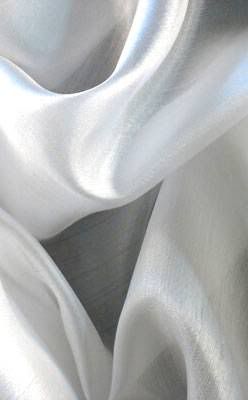This post is part of Ice Mom's Sewing Guide.
Other posts in this series: All about Patterns, All about Fabrics, How to Dye Silk for Fabric Skating Skirts, Altering Your Growing Skater's Figure Skating Dress, Laying out the Pattern.
This guest post is courtesy of reader C.M. who knows way more than I do about dyeing anything. Please realize that I have zero experience with dying silk or using silk for figure skating skirts. Post any questions about this technique in the comments. Thanks! Ice Mom.
I (guest poster C.M.) use the silk chiffon from the Dharma Trading Company. They have several different weights available. Any of them can be used for skirts: if you want a "fluffy" skirt with lots of layers, the silk gauze works well. For most standard skirts with two layers I use the medium weight chiffon (10 mm). If you want a non-see-through single layer skirt, the double chiffon is best. They also offer this fabric in black because it is very difficult to dye fabrics a true black color. Black is the only color that I would buy ready-made.
The great thing about dyeing silk is that it is very easy to dye on the stovetop (far easier than tie-dyeing). There are several products available for this. I would steer clear of RIT, Dylon, or any other dye available in a craft store. These are general-purpose dyes that do not react with the fibers to form a permanent bond. The colors are not bright and will fade/run over time. My favorite product is the Jacquard acid dye (you can get this from Dharma, or you can go to the manufacturer’s Website to see if any nearby stores stock it). This dye does a great job of giving results that are vibrant, even, and (very) permanent. It is very safe to use as the only other chemical you need is white vinegar. It is very concentrated and a small jar will go a long way.
I have been following the directions posted on the Dharma Website and I have yet to have any problems. When you receive the dye, there will be a swatch on the jar that indicates the color that the fabric will come out if it is fully saturated with dye. It cannot get any brighter/darker than that. The directions tell you how much dye is needed to fully saturate a pound of fiber. In order to determine how much dye you need, you should weigh your fabric (I have an inexpensive gram scale) and calculate how much dye you need from that. If you use more dye than this, some of it will not react with the fabric and will end up getting poured down the drain (these dyes are not all that hazardous, but it is best to be safe). If you want a lighter shade, you can cut the calculated amount of dye by a factor of 2, 4, etc. To get pastels, I cut it by a factor of 10. As long as you don't exceed the saturation point, there should be little to no color left in the dye bath once the simmering is complete.
I don't cut out the pieces of the skirt before dyeing because the edges of the fabric tend to come out a little darker. Once the process is over, you can rinse the fabric in a special detergent called synthrapol in order to remove any unreacted pigment (there is not a lot of excess runoff with this product, but it will soften the fabric). Once it is done, I hang it to dry. It is best to not put this fabric in the dryer because it will shrink and gain a crinkly texture. Once it's dry, it is good to sew. Just remember to cut the skirt a little bit bigger because it does not stretch.
The most nerve-wracking part about this process is getting the dyed fabric to match the Lycra. The best way to do this is to compare a swatch of your Lycra to the different colored dyes available and select closest color match. Some people are advanced enough that they can successfully mix colors; however I feel that the manufacturer offers enough colors (and most skaters select more or less "standard" colors for their dresses anyway). No matter how hard you try, you will not get an exact color match, but nobody is going to notice as long as it’s close. If you are anal about it, you can dye small swatches and take notes about how much dye you use. I just estimate using the swatch on the jar and I always get "in the ballpark" results.
When I first tried this, I had my doubts. However, after my first attempt, I was shocked at how nicely the fabric dyed. If you follow the directions and keep good notes, you cannot fail at this. Dharma as well as the manufacturer have great product support and are happy to answer your questions if you call them. It seems scary, but it is not that hard.
I have read that some designers also dye their own Lycra with this product (i.e. Sasha Cohen's seamstress). However, the same dye recipe will not yield the same color in the Lycra and the silk. This means that you have to use two different recipes to get the same color (not fun to figure out).
The dyeing technique that I described is only useful for solid color dyeing. I only use it when I need to match the silk to a colored lycra bodice. For example, if I were to make a royal blue dress, I would buy the blue lycra and I would dye the white silk to match the lycra as best as I could. I have heard that some people use tub dyeing to achieve an ombre effect, but I have never tried it, so I can't give you any advice on that. When it comes to doing an ombre effect, I use an airbrush with a special paint called dye-na-flo. This is a special paint that can be used with an airbrush on pretty much any fabric you like (not just silk). Just remember to follow the directions.
The link to the acid dyes (and their instructions) can be found here. You might notice that Sasha Cohen's seamstress is featured on this page for using this product (if it's good enough for her, it's good enough for me!).
Dharma offers silk chiffon in a few weights and any of them could be used depending on what type of skirt you like. This fabric is semi-sheer in most cases, so you will usually need to do multiple layers in order to avoid the see-through skirt. I almost always use the medium weight 10 mm. For this, you need to make a double-layer skirt.
If you want to make a single-layer skirt, use the double chiffon. It all depends on what look you are going for. I think having a see-thru skirt defeats the purpose of having a skirt, so I always double up or go with the thicker material. Be warned that the commercial patterns (such as Kwik-Sew) are designed to make skirts with stretch material, so you will need to cut the skirt a little bit bigger. Pin it to the bodice and have the skater try it on so you can make adjustments to the fullness.
I learned all of this from buying the products and trying them out for myself, so you might find something that works better for you. Unfortunately, a lot of dressmakers are very secretive about how they do things (especially when it comes to airbrushing), making trial and error the only way to learn. That being said, if you are interested in improving you need to be willing to be brave and try out things that have no promise of working. If you think things through before you do them, they usually work. It is also helpful if you have a skating friend who gets their dresses professionally made (and that you like the look of). If you ask them (nicely) to bring it with them to the rink, you can take a good look at them in inside and out to see how they are constructed/beaded etc. My sister (the skater in my family) had a friend who splurged for a Tania Bass dress that she let me take a look at.
Being able to study good examples of handmade dresses takes a lot of mystery out of the (often) mysterious world of making figure skating dresses. I think most skating designers started out as some skater's mom or relative that wanted to save money buy making their own, but ended up really enjoying it.
Thank you, C.M., for your excellent post! You’ve given me the courage to try dyeing silk for a skirt – the flowy effect looks stunning. I’m also asking for an airbrush for my birthday, I can tell you that!
Update: From reader Anonymous: The fabric that has worked very well for me is Glissenette. This is a sheer stretch fabric that doesn't roll at the edges when cut. It is easy to sew with and floats beautifully as the skater moves. It is available in limited colors so there is some matching difficulty. I order it from spandexhouse.com, spandexworld.com and Jone's fabric (more expensive, but bigger selection) There is a sheer nude color that I use over nude spandex for nude looking cut-out backs that still provide some warmth.
Update: From post author C.M.: Although this fabric does not contain any elastic fibers (making it a not suitable for bodice material), the fabric does have a little bit of stretch to it, which makes it a little more resilient. However, you still need to cut it slightly bigger and "gather" it around the bodice so the skater can still pull it on and off.
Update: From reader Anonymous: I airbrush with paint as dying on polyester is too much chemical manipulation for my liking, although I could do it if I was dedicated enough. [...] The secrets are in the products, dye vs paint. I've had great success with Jacquard products but they can be expensive.
Do you know more than Ice Mom? Great! E-mail me with your guest post! icemom.diane@gmail.com
Monday, February 1, 2010
Subscribe to:
Post Comments (Atom)












10 comments:
Why are skatedress makers so secretive??? That makes me crazy!!! It's the same in this region too. I feel like I have been blessed with the ability to sew and I love to share techniques and tips whenever I can. The more people who sew the better come ice show time. My skatedress making is an open book, oh well I guess i'm not a typical skatedress maker LOL
Hi, Becky.
No idea why so much secrecy.
Please consider this an invitation to open your book to us all! If you'd like to guest post, e-mail me at icemom.diane@gmail.com!
Thanks!
Ice Mom
Words can never express my gratitude for this information! I'm so excited to get started! Just waiting for the milliskin to show up and for Coach to "approve" the colors/design.
Mostly (in life) I've found other sewers to be very friendly and helpful. Then my daughter started skating, and I naturely offered to help in the costume room with the ice show. It was definitely a different culture...I'll still try to help, but this time I'll know not to expect any new "sewing BFFs" Besides, we've got Ice Mom!
Skating dresses is an interesting theme.Thanks site owner for useful information!
I sew for my own daughters who are relatively new skaters (taking pre-pre moves later this month). I find this sewing/dye topic fascinating. Why are you using silk, a non-stretch fabric, for these skirts when you could use the same lycra as the remainder of the dress or even a stretch mesh? Doesn't the silk tear away from the dress when the girls sit down? Can you provide links to pictures of dresses made in this manner? I am lucky to have a retail store nearby where I can select fabrics to make my girls' dresses.
Hi Beth,
I've just cut out and am hanging my first silk skirt, a layer of chiffon over a light satin silk (purchased as remnants) to test before i launch into my first dye attempt. Watch senior level skaters on TV and the fabric floats as they move. I've never been able to achieve this with strtch fabric, they always hang heavier. After cutting a "single circle" skirt, my daughter was able to pull the skirt over the skater butt, so I'm thinking I have enough give when I attach it to the pant and bodice. I'll keep you posted on lessons learned.
Alice just said what I was going to say.
Yes, Beth. You absolutely can use the same stretch fabric for the skirt and the bodice or another stretch fabric. Although there is nothing wrong with this (and a lot of people make their dresses this way), I find that you cannot achieve the same look. The silk chiffon has a very delicate appearance which looks nice at rest, but has a beautiful "ripple" effect when the skater is moving fast, similar to hanging a lightweight piece of fabric in the wind. You cannot achieve this effect with a stretchy fabric for some reason, although you can come kind of close by using a stretch mesh with a cut (not serged) edge. If you want to see pictures of this, just check out any dress that Sasha Cohen, Ashley Wagner, or Caroline Zhang wears in competition.
Although this fabric does not contain any elastic fibers (making it a not suitable for bodice material), the fabric does have a little bit of stretch to it, which makes it a little more resilient. However, you still need to cut it slightly bigger and "gather" it around the bodice so the skater can still pull it on and off.
Alice, good luck with the dyeing; be sure to report back how it all worked out!
I use polyester chiffon or georgette for skirts, mostly georgette because my supplier will colormatch to the spandex for the bodysuit. For the price point that I offer my customers, silk is just a bit too expensive, and it's delicate. My customers are low level test skaters and will wear their dress in practice, and once the competition is over, it's an everyday practice dress, so they have to last.
I airbrush with paint as dying on polyester is too much chemical manipulation for my liking, although I could do it if I was dedicated enough. I agree that other dressmakers are super secretive as to how they learned, and I have heard almost all of them talk about their trial and error. It's not so much the airbrush techniques, with the advent of youtube, there's lots to look at. The secrets are in the products, dye vs paint. I've had great success with Jacquard products but they can be expensive. I'm a paint airbrusher, but the other lady in the area that does "dip dye" is a dyer and uses silk for her skirts. I have ended up reattaching some of her skirts.
I learned to airbrush in art school a million years ago, so that was easy enough. It's been getting the right combinations of paint and fabric that has taken a lot of time.
There is another seamstress that paint airbrushes but her design skill is not good. There's no point painting a dress that fits badly or is not flattering.
I've made several skating dress and haven't used a silk skirt. I've always been afraid to because of the non-stretch fabric. I may try it in the future at some point.
The fabric that has worked very well for me is Glissenette. This is a sheer stretch fabric that doesn't roll at the edges when cut. It is easy to sew with and floats beautifully as the skater moves. It is available in limited colors so there is some matching difficulty. I order it from spandexhouse.com, spandexworld.com and Jone's fabric (more expensive, but bigger selection) There is a sheer nude color that I use over nude spandex for nude looking cut-out backs that still provide some warmth.
What I'm wondering is if there is a way to dye spandex/glissenette? Are the jaquard dyes only for silk? If I could dye white spandex and white glissenette any color, I would be one happy skating dress seamstress!
If the fabrics are nylon based they should dye well. Ask your supplier for fiber content of the fabrics.
Post a Comment